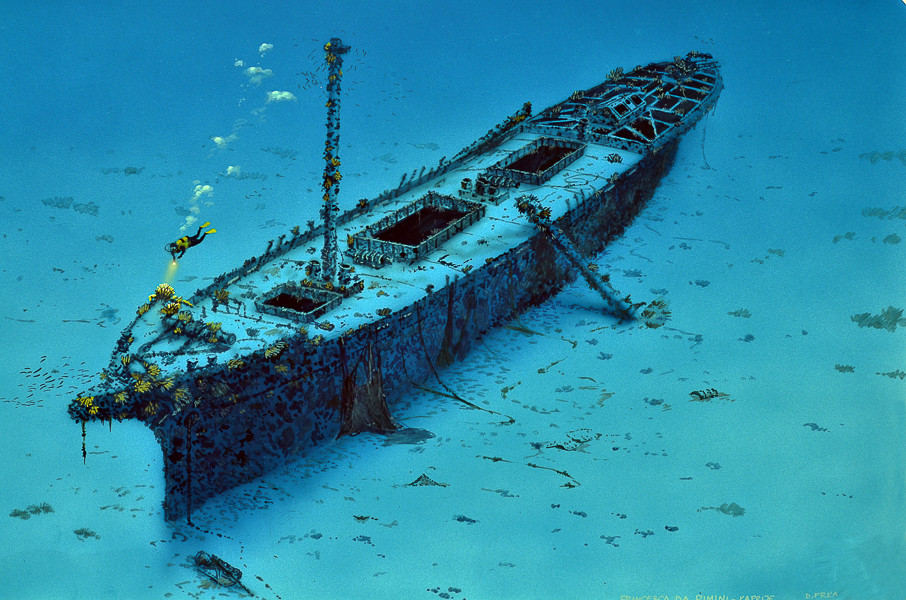
FRANCESCA DA RIMINI
DEPTH: 38 - 52 m
SKILL: Advanced
Francesca Da Rimini; motorsailer with steel hull and 3 masts;
Built: 1942, owner Rodolfo Gattoni e C. from Rijeka
Sunk: 2nd February 1944 (battle with a British motor torpedo boat and gunboat)
Dimensions: l=about 40 m, w=about 8.0 m h=1.20 m
Coordinates: 43.72198° N 15.67447° E
Location: N from the northern cape of the island of Kaprije, about 150 m from the shore
Access: 2/5 access is solely by boat (the location is 150 m away from the shore, but the terrain is inaccessible)
Visibility: 4/5 mostly good
Current: 4/5 moderate
Flora and fauna: 4/5 varied life on and around the wreck, occasionally specimens of large fish
HISTORY:
Based upon the book by author Dudley Pope under the title ‘Flag 4’ (a British signal for opening fire or launching torpedoes), the battle and sinking of the ship Francesca da Rimini are described with a date of 2nd February 1944, and the location of the sinking is in the Šibenik archipelago:
Two nights after the action of 31st January (1944), Bligh (boat MTB 662) and Hughes (boat MTB 649) broke through between the islands north of Šibenik and ignited the large fireworks. Leaving Komiža after 1700 hrs., the boats began patrolling between the Rogoznica and Zlarin channels.
At 2130 hrs. first officer on the 662 made an announcement: “Ship with three masts over the port bow”, they increased speed towards the enemy. The enemy spotted the boats after a minute and fired a white flare – a recognition signal and aimed its guns towards boat 662. Both sides opened fire at a distance of about 160 metres, the enemy was hit along the length of its hull and deck. Hughes followed with another barrage from close range, upon which the bow was set ablaze. It didn’t seem that the boat was breached below the waterline, so both ships repeated their attack. Then the ships stopped to pick up the survivors.
A real firework display then exploded from the ship. It appears that munitions had exploded near the guns, and Bligh withdrew his unit towards the west. The enemy ship still burned like a torch. Green, red and white signal flares continuously flew from the orange blaze at the centre, climbing into the sky and falling back down. At 2215 hrs. the enemy exploded in a really huge explosion, whose flames and smoke climbed over 300 metres high into the air. The unit reluctantly continued patrolling the south coast and returned to Komiža rather late through the thick fog. From the prisoners it was learned that the destroyed ship’s name was Francesca da Rimini of 350 tonnes. On its final voyage it was transporting 320 tonnes of ammunition, 10 tonnes of equipment, 15 tonnes of blankets, one small truck and a motorcycle. On the ship there were 25 German soldiers travelling as passengers, who were assumed to have perished. The crew was made up of five Germans as gun attendants and nine Italians. Bligh’s craft was hit with a few 20 mm shells, but beside a superficial injury to one of its gunners, there were no casualties. The MTB 649 was not damaged nor did it have any casualties.
WRECK CONDITION AND DIVING:
Although the Francesca da Rimini lies submerged at only 150 metres from the north shore of the island of Kaprije, it is a dive deep into the blue as the stern, which is the shallowest part of the wreck, lies at a depth of 38-40 m. There is usually an anchored buoy which is used as mooring for scuba diving boats. Descending towards the stern, we immediately notice its curved lines typical of sailing ships, and in the middle of the stern our eyes first catch on a large object which is overgrown with a thick mound of yellow sponges. This is the four-barrelled 20 mm calibre anti-aircraft gun. In front of the remains of the superstructure, as well as at the stern, there is a square sheet-metal construction with lids and round openings, which were actually the ventilation hatches of the engine room. In front of the skylight are the remains of the stern mast, which lies broken across the deck.
Swimming towards the centre of the boat we come across the hatch of the cargo holds. Dropping into the interior we need a few moments to accustom our eyes to the gloom, but can then make out that most of the cargo was not destroyed in the fire. The enormous amount of gun shells of various calibres and other military equipment are still today in place in the cargo holds. One large conger eel disappears into the dark of the cargo holds, as though he hasn’t become accustomed to the divers who are frequent guests inside. Unfortunately here we become witnesses to the unsuccessful and completely unnecessary project of supposed “protection” for divers, in order that they do not touch the dangerous cargo (shells) which the ship was transporting: over the part of the cargo, in no apparent order, are thrown ugly steel meshes of construction rods (armature), and over them are thrown several PVC bags with sand. People believed that with the help of nets they would increase safety for the divers, which they did not succeed, but instead with the nets and bags they have ended up defacing the interior of the wreck and reduced its attractiveness (and in this they did succeed). The value of each wreck is exactly that is stays on the sea bottom “frozen” in the same state as the moment it sank, and it’s precisely this authenticity that leaves an indelible impression on the underwater visitors.
Crossing over yet another opening to the cargo hold we approach the base of the foremast and the bow, which is also the deepest part of the wreck. Dropping to the bottom not far away from the bow we come across the bow gun with its shield. Someone had mentioned that somewhere in the ship’s surroundings there are also the remains of a vehicle, however the depth here is 52 metres so it needs to be taken into account that to the stern and cable for the ascent at least several minutes are required, therefore there is no extra room for unplanned trips around the ship.
The description and illustrations are a courtesy of Danijel Frka and Jasen Mesić. Buy the whole book here: https://shop.naklada-val.hr/product_info.php?products_id=561
Built: 1942, owner Rodolfo Gattoni e C. from Rijeka
Sunk: 2nd February 1944 (battle with a British motor torpedo boat and gunboat)
Dimensions: l=about 40 m, w=about 8.0 m h=1.20 m
Coordinates: 43.72198° N 15.67447° E
Location: N from the northern cape of the island of Kaprije, about 150 m from the shore
Access: 2/5 access is solely by boat (the location is 150 m away from the shore, but the terrain is inaccessible)
Visibility: 4/5 mostly good
Current: 4/5 moderate
Flora and fauna: 4/5 varied life on and around the wreck, occasionally specimens of large fish
HISTORY:
Based upon the book by author Dudley Pope under the title ‘Flag 4’ (a British signal for opening fire or launching torpedoes), the battle and sinking of the ship Francesca da Rimini are described with a date of 2nd February 1944, and the location of the sinking is in the Šibenik archipelago:
Two nights after the action of 31st January (1944), Bligh (boat MTB 662) and Hughes (boat MTB 649) broke through between the islands north of Šibenik and ignited the large fireworks. Leaving Komiža after 1700 hrs., the boats began patrolling between the Rogoznica and Zlarin channels.
At 2130 hrs. first officer on the 662 made an announcement: “Ship with three masts over the port bow”, they increased speed towards the enemy. The enemy spotted the boats after a minute and fired a white flare – a recognition signal and aimed its guns towards boat 662. Both sides opened fire at a distance of about 160 metres, the enemy was hit along the length of its hull and deck. Hughes followed with another barrage from close range, upon which the bow was set ablaze. It didn’t seem that the boat was breached below the waterline, so both ships repeated their attack. Then the ships stopped to pick up the survivors.
A real firework display then exploded from the ship. It appears that munitions had exploded near the guns, and Bligh withdrew his unit towards the west. The enemy ship still burned like a torch. Green, red and white signal flares continuously flew from the orange blaze at the centre, climbing into the sky and falling back down. At 2215 hrs. the enemy exploded in a really huge explosion, whose flames and smoke climbed over 300 metres high into the air. The unit reluctantly continued patrolling the south coast and returned to Komiža rather late through the thick fog. From the prisoners it was learned that the destroyed ship’s name was Francesca da Rimini of 350 tonnes. On its final voyage it was transporting 320 tonnes of ammunition, 10 tonnes of equipment, 15 tonnes of blankets, one small truck and a motorcycle. On the ship there were 25 German soldiers travelling as passengers, who were assumed to have perished. The crew was made up of five Germans as gun attendants and nine Italians. Bligh’s craft was hit with a few 20 mm shells, but beside a superficial injury to one of its gunners, there were no casualties. The MTB 649 was not damaged nor did it have any casualties.
WRECK CONDITION AND DIVING:
Although the Francesca da Rimini lies submerged at only 150 metres from the north shore of the island of Kaprije, it is a dive deep into the blue as the stern, which is the shallowest part of the wreck, lies at a depth of 38-40 m. There is usually an anchored buoy which is used as mooring for scuba diving boats. Descending towards the stern, we immediately notice its curved lines typical of sailing ships, and in the middle of the stern our eyes first catch on a large object which is overgrown with a thick mound of yellow sponges. This is the four-barrelled 20 mm calibre anti-aircraft gun. In front of the remains of the superstructure, as well as at the stern, there is a square sheet-metal construction with lids and round openings, which were actually the ventilation hatches of the engine room. In front of the skylight are the remains of the stern mast, which lies broken across the deck.
Swimming towards the centre of the boat we come across the hatch of the cargo holds. Dropping into the interior we need a few moments to accustom our eyes to the gloom, but can then make out that most of the cargo was not destroyed in the fire. The enormous amount of gun shells of various calibres and other military equipment are still today in place in the cargo holds. One large conger eel disappears into the dark of the cargo holds, as though he hasn’t become accustomed to the divers who are frequent guests inside. Unfortunately here we become witnesses to the unsuccessful and completely unnecessary project of supposed “protection” for divers, in order that they do not touch the dangerous cargo (shells) which the ship was transporting: over the part of the cargo, in no apparent order, are thrown ugly steel meshes of construction rods (armature), and over them are thrown several PVC bags with sand. People believed that with the help of nets they would increase safety for the divers, which they did not succeed, but instead with the nets and bags they have ended up defacing the interior of the wreck and reduced its attractiveness (and in this they did succeed). The value of each wreck is exactly that is stays on the sea bottom “frozen” in the same state as the moment it sank, and it’s precisely this authenticity that leaves an indelible impression on the underwater visitors.
Crossing over yet another opening to the cargo hold we approach the base of the foremast and the bow, which is also the deepest part of the wreck. Dropping to the bottom not far away from the bow we come across the bow gun with its shield. Someone had mentioned that somewhere in the ship’s surroundings there are also the remains of a vehicle, however the depth here is 52 metres so it needs to be taken into account that to the stern and cable for the ascent at least several minutes are required, therefore there is no extra room for unplanned trips around the ship.
The description and illustrations are a courtesy of Danijel Frka and Jasen Mesić. Buy the whole book here: https://shop.naklada-val.hr/product_info.php?products_id=561

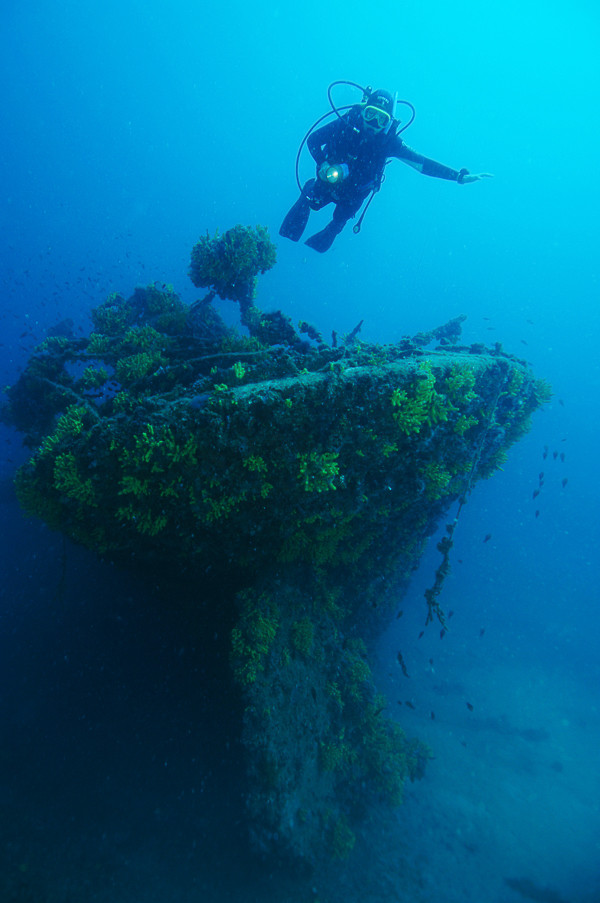


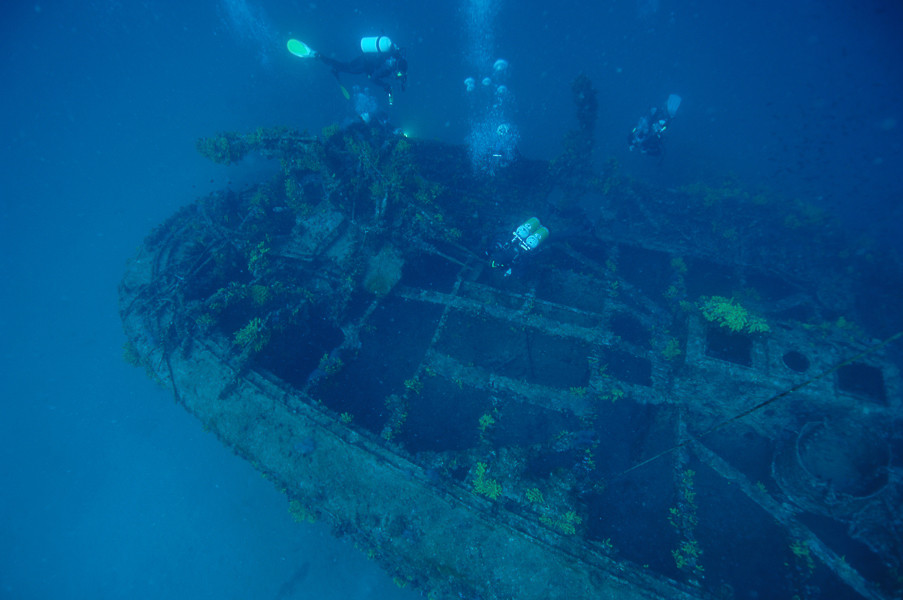
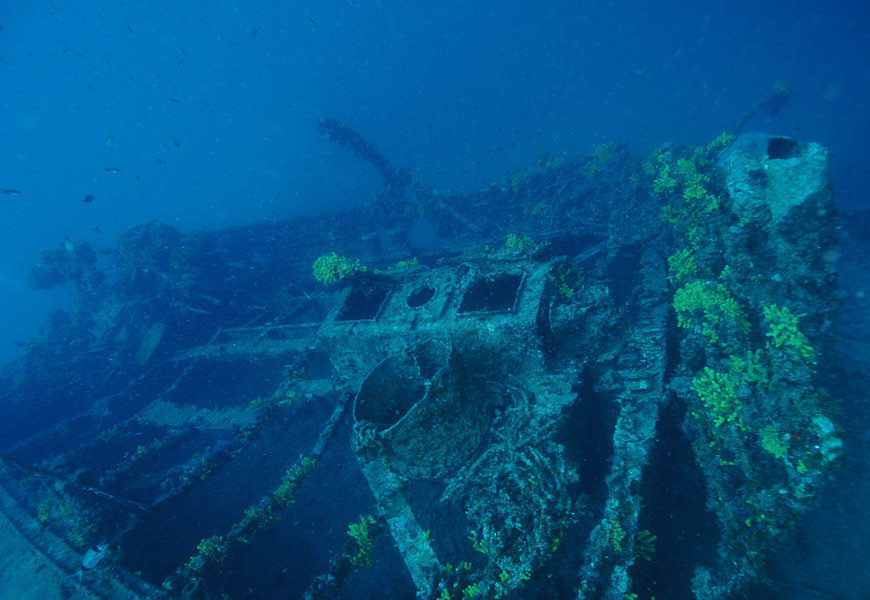
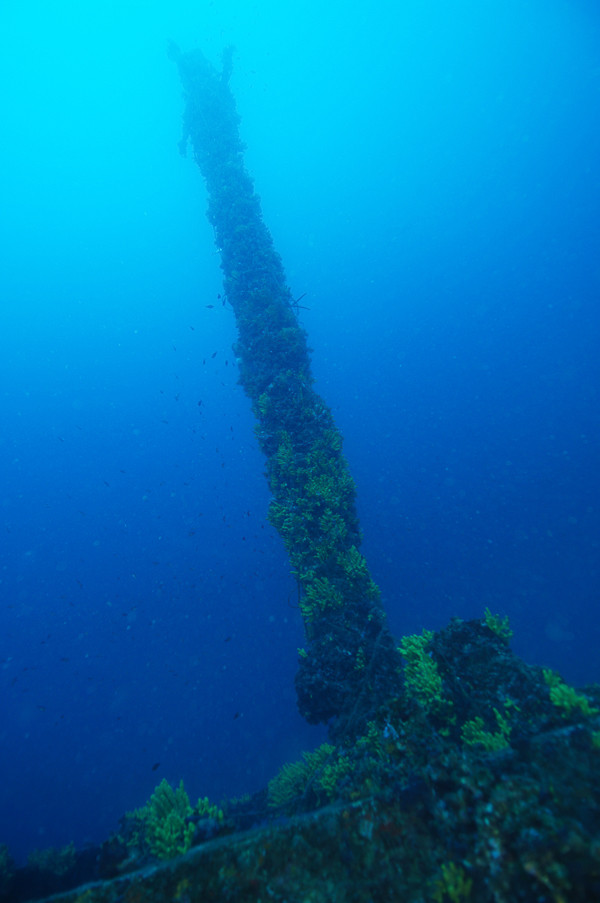
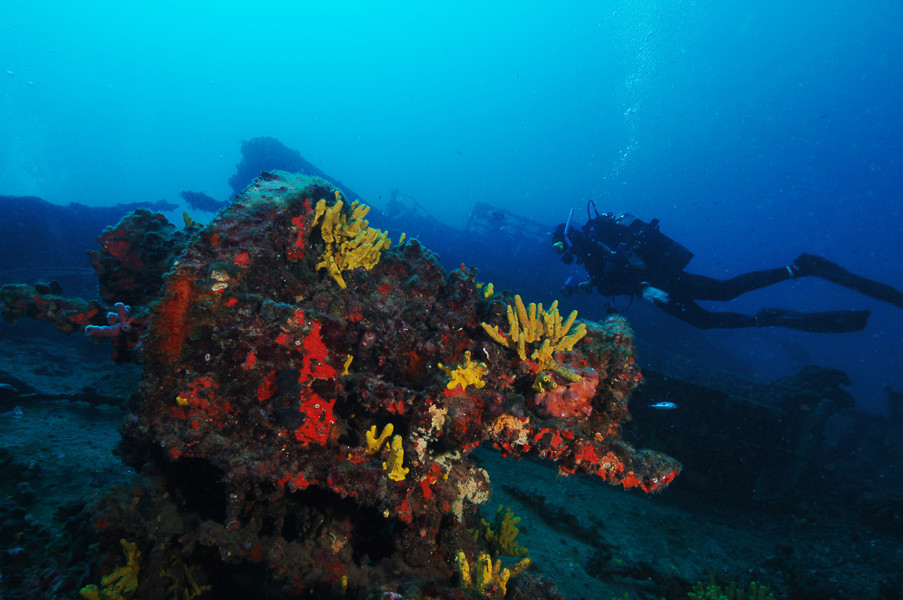
 The investment is co-financed by the Republic of Slovenia and the European Union from the European Regional Development Fund.
The investment is co-financed by the Republic of Slovenia and the European Union from the European Regional Development Fund.  H2O Globe BETA
H2O Globe BETA